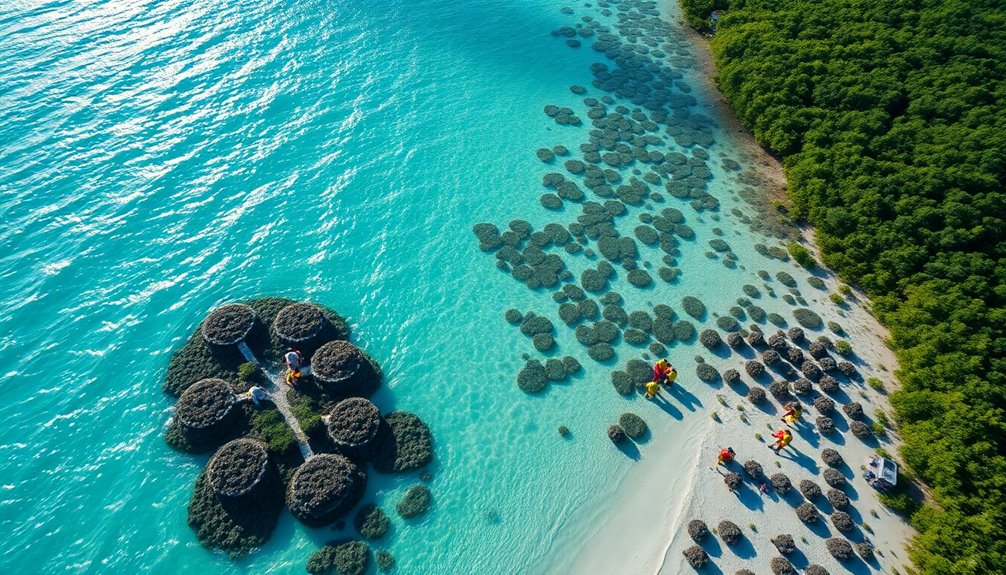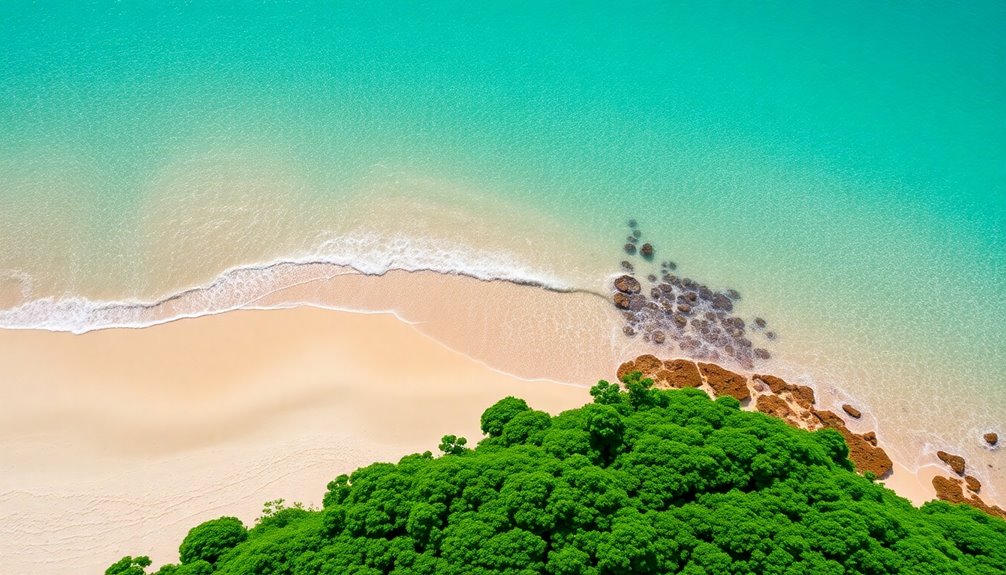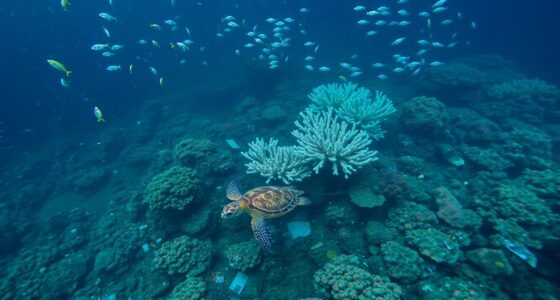Coastal Guardians are redefining protection for the Florida Keys through innovative, nature-based solutions. They focus on restoring mangroves and enhancing coastal ecosystems to combat rising sea levels and storm impacts. With advanced GIS technology, they identify suitable areas for intervention, blending natural and engineered strategies. This approach not only stabilizes shorelines but also boosts biodiversity and community resilience. If you want to discover how these methods are reshaping the future, keep exploring their ongoing initiatives.
Key Takeaways
- Coastal Guardians implement nature-based solutions like mangrove restoration to stabilize Florida Keys shorelines and enhance local ecosystems.
- Advanced GIS technology helps identify strategic areas for shoreline interventions, despite geographic limitations.
- The integration of hybrid solutions combines natural elements with engineered structures to combat erosion and flooding risks.
- A multi-criteria decision tool assesses and prioritizes shoreline stabilization methods based on exposure risks and existing conditions.
- Collaboration among stakeholders and visualization tools aids in effective planning and safeguarding of Florida Keys' unique shorelines.

As rising sea levels and more frequent storms threaten the delicate ecosystems of the Florida Keys, the efforts of Coastal Guardians are becoming increasingly vital. They focus on using nature-based solutions, like mangrove restoration and coastal strand enhancement, to stabilize shorelines and enhance local ecosystems. These methods not only provide crucial protection but also support biodiversity by creating habitats for various species.
You might be surprised to learn that only about 8% of the Florida Keys coastline is suitable for these solutions, while a significant portion is unsuitable or already vegetated. Coastal Guardians utilize advanced GIS technology to strategically identify areas where both nature-based and hybrid solutions can be implemented. By combining natural elements with engineered structures, they create effective barriers against erosion and wave action, addressing the pressing challenges posed by climate change.
The urgency for these strategies becomes clear when you consider the predicted sea level rise of up to 0.30 meters by 2050 and the increased frequency of hurricanes like Irma and Ian. These events underscore the necessity of adapting shoreline management techniques to protect infrastructure and ecosystems alike. Nature-based solutions not only enhance the environment but also contribute to community resilience against flooding, particularly in light of the increased flooding risks associated with rising sea levels.
Coastal Guardians leverage a multi-criteria decision tool developed by FAU and The Nature Conservancy to assess the suitability of shoreline stabilization methods. This tool integrates spatial data and expert input, allowing for informed decisions based on the Shoreline Relative Exposure Index. It prioritizes projects by evaluating exposure risks and existing shoreline conditions, ensuring that resources are allocated effectively.
In this collaboration among private stakeholders and public entities, the integration of expertise from coastal engineering to marine biology plays a crucial role. With initiatives like the Coastal Resilience tool from The Nature Conservancy, you can visualize the impact of sea level rise and land use, paving the way for coordinated efforts to safeguard the Florida Keys' unique shorelines.
Frequently Asked Questions
What Are the Coastal Guardians' Goals for the Florida Keys?
Coastal Guardians aim to enhance ecosystem resilience, mitigate erosion, and protect vital infrastructure in the Florida Keys.
They're focused on promoting sustainable practices among stakeholders and fostering community adaptation through effective shoreline management.
By addressing challenges like sea level rise and hurricane vulnerability, you'll see them implementing innovative strategies, such as nature-based solutions and hybrid approaches.
Their mission also includes engaging the community to ensure a holistic and sustainable coastal environment.
How Can I Get Involved With the Coastal Guardians?
If you want to get involved with the Coastal Guardians, start by reaching out to them through their website or social media.
They often need volunteers for various projects, from shoreline restoration to community engagement efforts.
You might also consider participating in local events or workshops they host.
Collaborating with nearby organizations can amplify your impact, so don't hesitate to explore partnership opportunities in your community for coastal protection initiatives.
What Challenges Do Coastal Guardians Face in Their Efforts?
Coastal guardians face numerous challenges in their efforts.
You'll encounter geographical obstacles like low-lying shorelines that increase flood risks. Climate change exacerbates these issues, with rising sea levels and stronger storms threatening ecosystems.
There's also pressure from growing populations and tourism, which can harm marine habitats. Limited areas suitable for nature-based solutions complicate restoration efforts.
Additionally, engaging local communities and navigating regulatory changes are essential for successful conservation and management strategies.
Are There Any Costs Associated With Coastal Guardians' Programs?
Are Coastal Guardians secretly hoarding treasure maps? Because when it comes to funding their shoreline protection projects, there's not much detail available!
You'll find no specific costs listed, but state and federal grants might toss some coins their way.
Sure, creating jobs and boosting tourism sounds great, but they'll need collaboration from various stakeholders to make it happen.
How Often Will the New Methods Be Evaluated for Effectiveness?
You can expect the new methods to be evaluated periodically, typically every 1 to 5 years, depending on environmental changes and funding.
Significant events, like hurricanes, may prompt more frequent assessments.
Advanced tools, including GIS and machine learning, will help analyze data continuously, allowing for real-time adjustments.
Engaging stakeholders throughout this process ensures that evaluations remain relevant and effective, ultimately refining strategies for shoreline protection and resilience against climate impacts.
Conclusion
As you explore the Florida Keys, you can't help but wonder: what if these innovative methods truly reshape the coastline? With coastal guardians leading the charge, the future looks promising, but the stakes are high. Can these bold strategies withstand the test of nature's fury? As you gaze at the shimmering waters, remember that the fate of these shorelines hangs in the balance. The real question remains—will their efforts succeed, or will the tides of change prove too strong?






